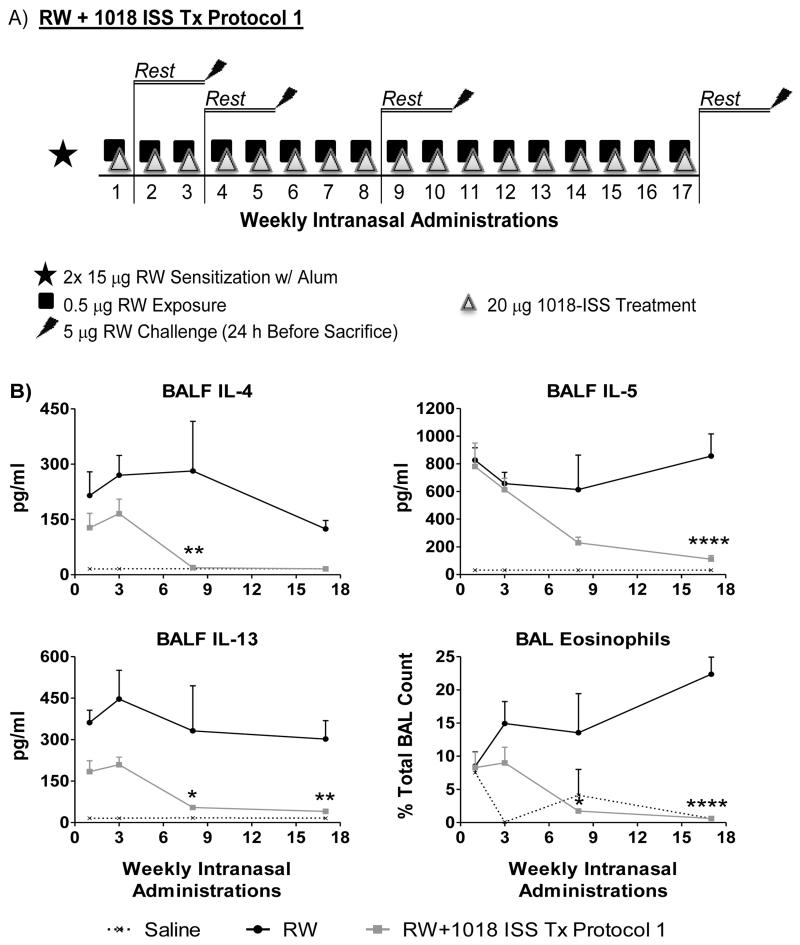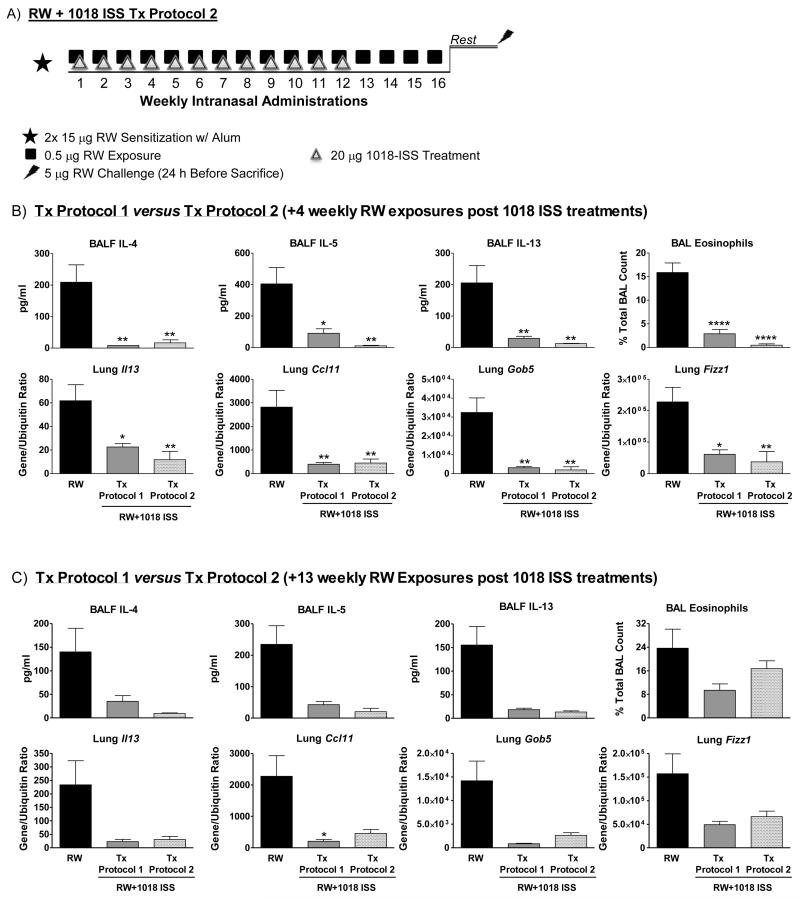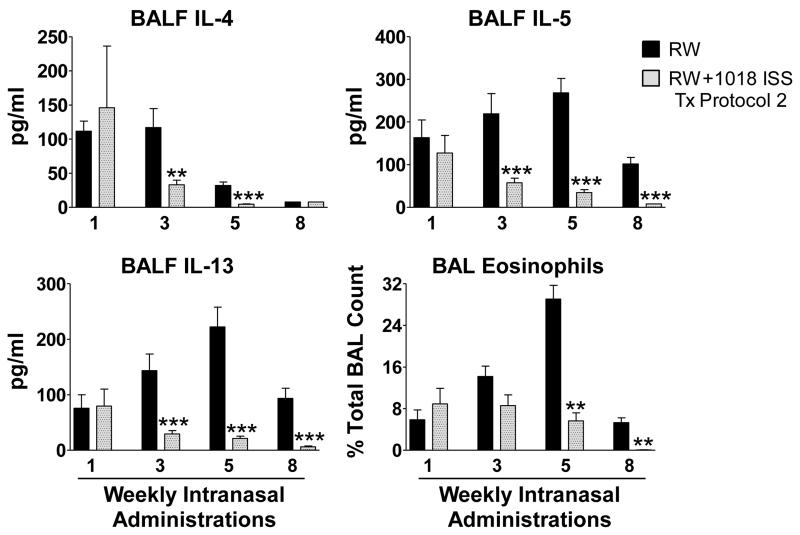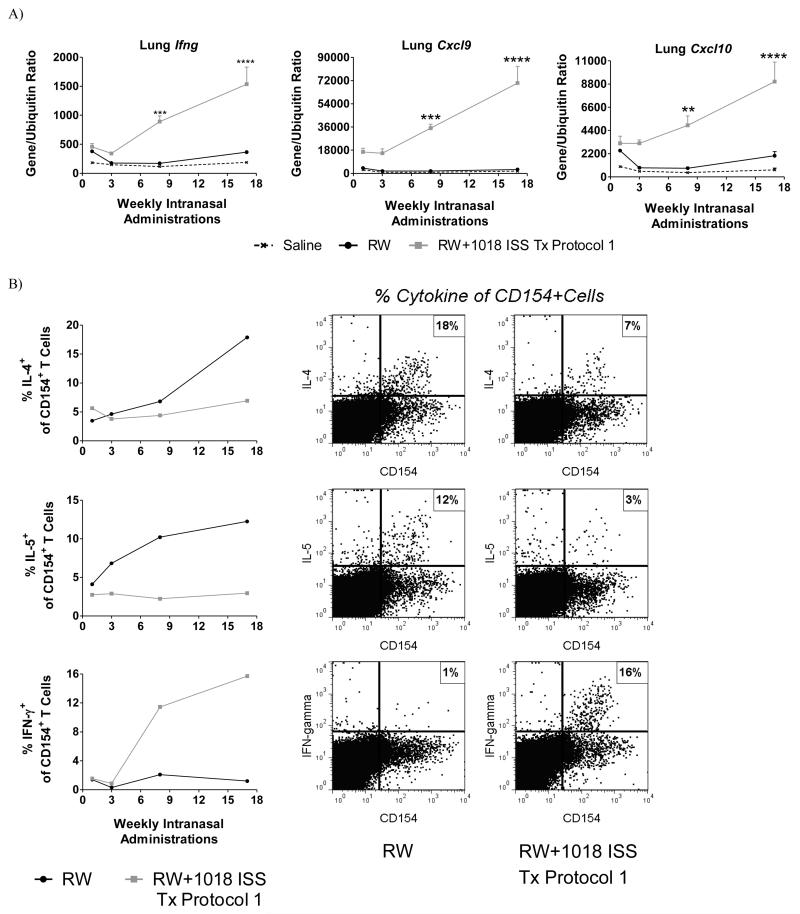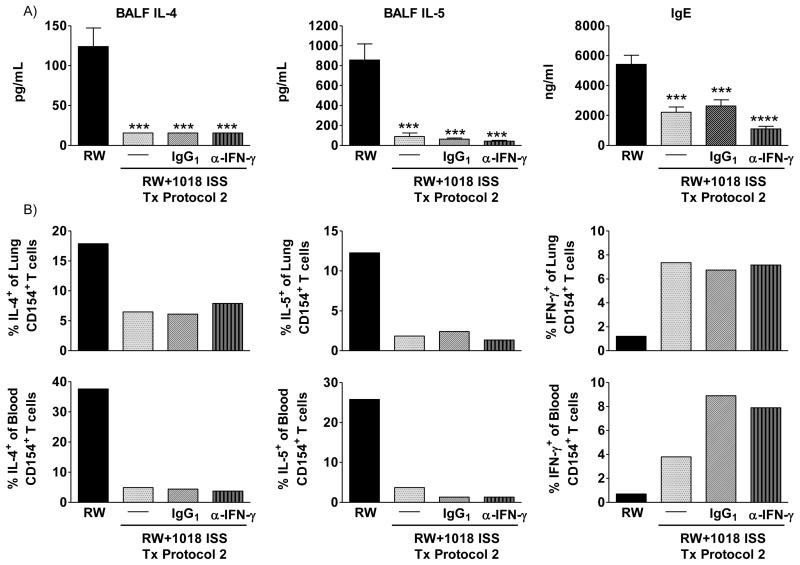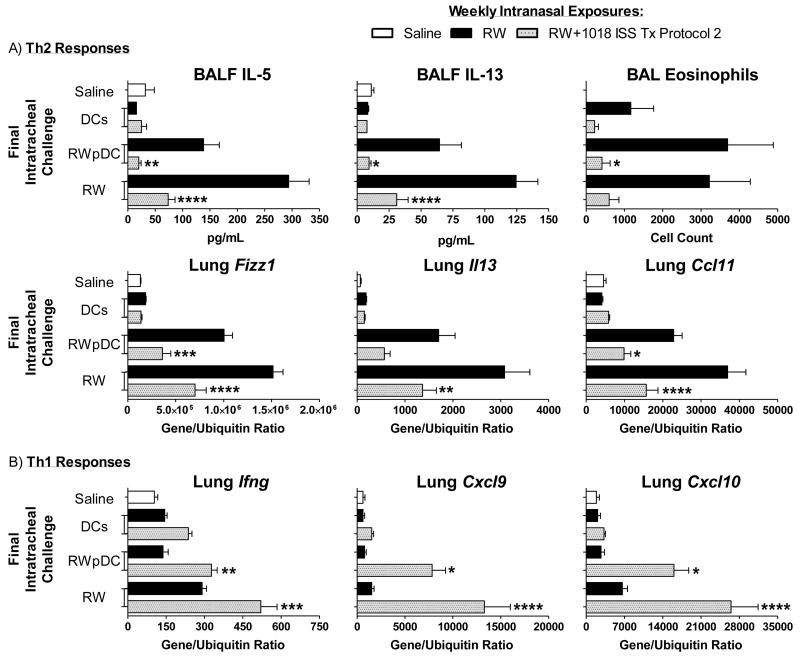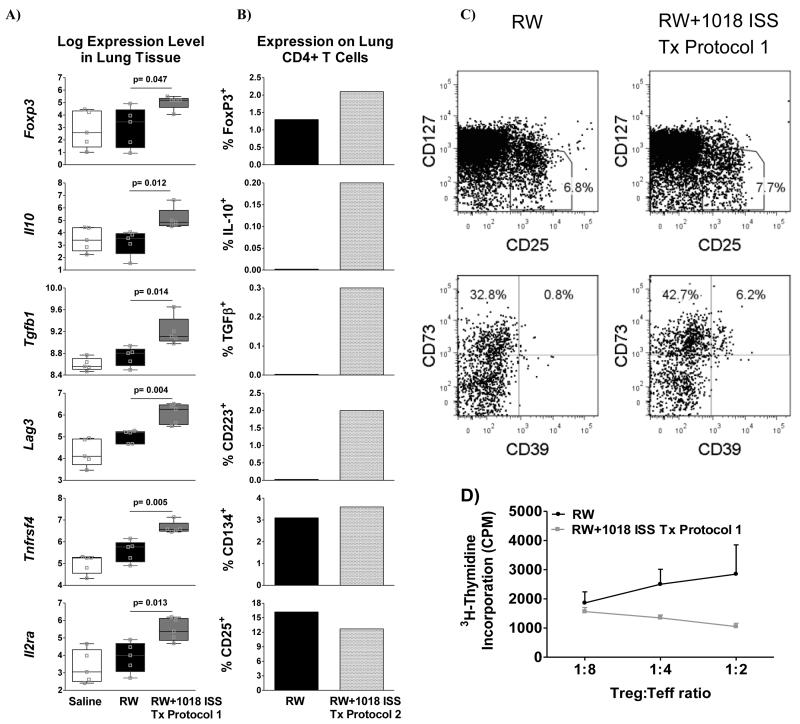Abstract
Background
CpG-containing oligodeoxynucleotides (CpG-ODN) are potent inhibitors of Th2-mediated allergic airway disease in sensitized mice challenged with allergen. A single treatment has transient effects but a limited series of treatments has potential to achieve clinically meaningful sustained inhibition of allergic airway disease.
Objective
To optimize the treatment regimen and determine the mechanisms of action in mice of an inhaled form of CpG-ODN being developed for human asthma treatment.
Methods
A limited series of weekly intranasal 1018 ISS (CpG-ODN; B-class) treatments were given to ragweed allergen-sensitized mice chronically exposed to allergen during and after the 1018 ISS treatment regimen. Treatment effects were evaluated by measuring effect on lung Th2 cytokines and eosinophilia as well as lung dendritic cell function and T cell responses.
Results
Twelve intranasal 1018 ISS treatments induced significant suppression of BAL eosinophilia and IL-4, IL-5, and IL-13 levels and suppression was maintained through 13 weekly ragweed exposures administered after treatment cessation. At least 5 treatments were required for lasting Th2 suppression. CpG-ODN induced moderate Th1 responses but Th2 suppression did not require IFN-γ. Th2 suppression was associated with induction of a regulatory T cell response.
Conclusion
A short series of CpG-ODN treatments results in sustained suppression of allergic lung inflammation induced by a clinically relevant allergen.
Keywords: Allergic airway inflammation, asthma, CpG-containing oligodeoxynucleotides, dendritic cells, disease-modification, mouse, ragweed, therapy, T cells
Introduction
Current treatment options for allergic asthma: bronchodilators which improve lung function and corticosteroids which reduce lung inflammation, provide temporary relief but do not address the causes underlying allergic disease 1. Allergen-specific immunotherapy provides long-term relief for allergic rhinitis but is not as effective for asthma 2-5. Thus, the need to develop treatment alternatives for asthma that have long-lasting, disease-modifying effects is apparent 6.
The potential of CpG-containing oligodeoxynucleotides (CpG-ODN) as an immune-modulating therapy for allergic asthma has been demonstrated in many animal models. CpG-ODN stimulate innate and adaptive immune responses through TLR9 expressed principally by plasmacytoid dendritic cells (pDCs) and B cells in humans 7, 8. In allergen challenge models, prophylactic or therapeutic CpG-ODN administration inhibited airway hyperresponsiveness, mucus secretion, eosinophilia, Th2 cytokine levels, and Th2 migration to the lung 9-17. Long-term treatment models in mice and monkeys (3 to 6 months in duration) demonstrate inhibition of lung inflammation and remodeling in the presence of continued CpG-ODN dosing 18-24. However, enduring suppression of Th2 responses in the presence of frequent allergen exposures long after completion of a limited CpG-ODN treatment course, a model more relevant to clinical application, has not been demonstrated in animal models of allergic asthma.
Evidence that brief treatment with CpG-ODN could produce long-term suppression of allergic disease comes from clinical studies using the CpG-ODN 1018 ISS conjugated to the major ragweed allergen Amb a 1. Studies showed that 6 doses result in lower nasal and systemic Th2 responses with reduction in allergy symptoms for two ragweed seasons after treatment 25-27.
CpG-ODN therapy thus has potential for durable disease modifying effects. The optimum strategy for treating allergic asthma, usually triggered by multiple allergens, is application directly to respiratory tract, the site of offending allergen exposure. However, treatment optimization requires a better understanding of the treatment regimens and mechanisms needed to produce long term suppression of allergic disease. Thus, we developed a chronic mouse model focused on therapeutic delivery of free 1018 ISS directly to the airways via intranasal administration. We demonstrate that a short series of weekly treatments with free CpG-ODN induces months-long inhibition of lung Th2 responses to ragweed. We assessed the contributions of dendritic cell function as well as T cell subset responses to the maintenance of this CpG-ODN-induced disease modification.
Results
A series of 1018 ISS treatments induces long-lasting suppression of allergic responses of mice chronically exposed to ragweed
To test whether ongoing CpG-ODN treatments could affect and maintain inhibition of lung Th2 responses, we developed a murine allergic asthma model with a treatment and allergen exposure pattern intended to mimic the clinical delivery of inhaled CpG-ODN to patients. After sensitization to RW in alum, mice were exposed weekly to low dose intranasal (0.5 μg) RW. Treated mice received 20 μg 1018 ISS intranasally with weekly RW exposures (Tx Protocol 1, Fig 1, A). Treatment Protocol 1 represents continual concurrent weekly allergen exposures and 1018 ISS treatments. Groups of mice were sacrificed after 1, 3, 8 and 17 weeks of treatments in order to determine how many weekly treatments were required to suppress inflammation in the presence of ongoing allergen challenges. To assess treatment effects without the confounding effects of the direct response to 1018 ISS, mice were rested for 2 weeks before a final challenge with a high dose (5 μg) of RW. Control mice were sensitized to RW, but exposed to saline thereafter.
Fig 1. 1018 ISS treatments progressively suppress airway Th2 responses.
A, Tx protocol 1: 1, 3, 8, or 17 weekly intranasal saline, RW, or RW+1018 ISS treatments, 2 weeks rest, and a final RW challenge 24 hours before sacrifice. B, BALF cytokines and eosinophils (mean ± SEM, 5 mice/group). *P<0.05, **P<0.01, or ***P<0.0001, compared to RW. 1 representative experiment of 4 shown.
Chronic RW exposures induced a Th2-polarized lung inflammation, with large increases in IL-4, IL-5, and IL-13 protein and BAL eosinophilia (Fig 1, B), which continued through 17 weekly allergen challenges. Intranasal 1018 ISS, in conjunction with weekly RW exposures (Tx Protocol 1), resulted in a sharp reduction to background of all markers of Th2 activity by 8 weeks and continuing through 17 weeks of exposure to RW plus 1018 ISS (Fig 1, B).
To determine whether a limited course of CpG-ODN treatment had durable effects in chronically allergen-exposed mice, some groups received weekly allergen exposures after completion of a course of 1018 ISS (Tx Protocol 2, Fig 2, A). Treatment Protocol 2 represents a limited course of weekly allergen and 1018 ISS exposures, followed by continued weekly exposures to allergen alone. Strikingly, allergic responses were inhibited equally well in mice administered 12 weekly RW+1018 ISS treatments followed by 4 weekly RW exposures (Tx Protocol 2) or mice administered 16 weekly RW+1018 ISS treatments (Tx Protocol 1). BALF Th2 cytokines, BAL eosinophil levels, and lung Th2-associated genes Il13, Ccl11, Gob5 and Fizz1 were suppressed to a comparable extent with either protocol (Fig 2, B). Subsequent experiments showed that Tx Protocol 2 was highly effective even when as many as 13 weekly RW exposures were administered after the series of 12 weekly 1018 ISS treatments (Fig 2, C). Thus a limited series of CpG-ODN treatments inhibited allergic lung inflammation for over 3 months after treatment in the presence of continued weekly allergen challenges.
Fig 2. Limited 1018 ISS treatments induce lasting suppression of airway Th2 responses.
A, Tx Protocol 2: Groups similar to Tx Protocol 1 except that 1018 ISS was given for 12 weeks, followed by either 4 (B) or 13 (C) weekly RW only exposures. BALF cytokines, eosinophils, and lung gene expression shown (mean ± SEM, 5 mice/group). *P<0.05, **P<0.01, and ***P<0.0001, compared to RW. 1 representative experiment of 4 shown.
To determine the minimum number of treatments required for stable disease modification, Tx protocol 2 was varied to include groups receiving 1, 3, 5, or 8 weekly RW+1018 ISS treatments, followed by 4 additional weekly RW exposures each. At least 5 weekly 1018 ISS treatments were required to achieve significant, lasting reduction of Th2-mediated responses to continued allergen exposure (Fig 3). This suggests that a limited series of 1018 ISS treatments can produce a lasting reduction of Th2-based immune dysfunction in allergic asthma.
Fig 3. Five weekly 1018 ISS treatments are required for durable suppression of allergen-induced Th2 responses in the airways.
Tx protocol 2 with 1, 3, 5, or 8 weekly RW+1018 ISS treatments followed by 4 weekly RW exposures, compared to continual RW exposures. BALF cytokines and eosinophils depicted (mean ± SEM, 5 mice/group). **P <0.01 and ***P<0.001, compared to RW. 1 representative experiment of 2 shown.
1018 ISS treatments induce a shift from a ragweed-specific Th2 to Th1 response
To determine whether CpG-ODN treatments induced a Th1 shift in lungs of RW allergen-exposed mice, we measured lung Th1-associated genes. CpG-ODN are expected to enhance Th1 responses and this was demonstrated by the progressive increase in expression of the Th1-associated genes, Ifng, Cxcl9, and Cxcl10 in mice receiving RW+1018 ISS but not RW only (Fig 4, A; Tx Protocol 1). This progressive Th2 to Th1-like shift in RW+1018 ISS-treated mice was observed directly in ragweed-specific lung T cells (Fig 4, B). Following ex vivo re-stimulation with RW, lung-derived antigen-specific CD4+ T cells were identified by de novo expression of CD154 28-30. After 17 weekly RW exposures, these cells were predominantly Th2-like, but predominantly Th1-like in mice treated 17 weeks with RW+1018 ISS (Tx Protocol 1; Fig 4, C). Secreted BALF IFN-γ protein, however, was below the limit of ELISA detection (13 pg/mL), suggesting only a moderate induction of Th1 responses in 1018 ISS treated mice. The Th1 shift in lungs was reflected systemically as indicated by reduced IgE levels and elevated IgG2a levels in serum of mice administered RW+1018 ISS (Tx Protocol 1; see Fig E1 in this article’s Online Repository at www.jacionline.org).
Fig 4. 1018 ISS progressively induces a Th1 shift in lungs of treated mice.
A) Lung gene expression (mean ± SEM, 5 mice/group; Tx Protocol 1). **P <0.01,***P <0.001, and ****P<0.0001, compared to RW. B) Kinetics of intracellular cytokine expression as a proportion of CD154+ cells (lung tissue pooled per group), C) Intracellular cytokine expression after 17 weeks of Tx Protocol 1. Data representative of 2-4 experiments.
To determine the role of IFN-γ in maintenance of the Th2 to Th1 shift induced by 1018 ISS, mice were administered 13 weekly RW+1018 ISS treatments (Tx Protocol 2) and were then treated with anti-IFN-γ antibody, isotype control antibody, or no antibody during 4 weekly post-treatment RW exposures. Once established, the lasting Th2 suppression resulting from 1018 ISS was not reversed by IFN-γ neutralization. BALF IL-4, IL-5, and serum IgE as well as levels of IL-4 or IL-5-expressing RW-specific T cells in the lung or blood remained low in anti-IFN-γ treated mice (Fig 5, A-B). Inhibition of lung Cxcl9 and Cxcl10 expression in RW+1018 ISS-treated mice confirmed the activity of IFN-γ antibodies (data not shown).
Fig 5. IFN-γ is not required for maintenance of 1018 ISS-induced disease modification.
Tx Protocol 2: 13 weekly RW+1018 ISS treatments were followed by 4 weekly RW exposures ± antibodies. A) BALF cytokines and serum IgE (mean ± SEM, 5 mice/group). ***P<0.001, ****P<0.0001, compared to RW. B) Antigen-specific intracellular cytokine expression (tissue pooled/group). Data representative of 2 experiments.
Ragweed-pulsed dendritic cells cannot restore allergic responses in 1018 ISS-treated mice
A single CpG-ODN treatment inhibits the ability of lung APC to activate Th2 cells 31. To determine whether APC dysfunction could explain the durable Th2 suppression resulting from 1018 ISS treatment, mice were challenged with exogenous APC pulsed with RW antigen. Intra-tracheal challenge with allergen-pulsed BMDCs, is comparable to airway allergen challenge and sufficient to induce all features of allergic airway inflammation in sensitized mice 32-34. Mice given 5 weekly treatments with RW+1018 ISS, followed by 4 weekly RW exposures (Tx Protocol 2) were challenged with RW-pulsed BMDCs (RWpDCs), untreated DC, RW, or saline. RW-exposed mice challenged with RWpDCs had elevated BALF IL-5 and IL-13, BAL eosinophils, and lung Th2-associated genes (Fig 6, A). However, RWpDCs did not restore Th2 responses in 1018 ISS-treated mice (Fig 6, A), but rather induced expression of the Th1-associated genes Ifng, Cxcl9, and Cxcl10 (Fig 6, B). Thus, allergen presented by DCs never exposed to 1018 ISS did not restore the Th2 response to RW in 1018-treated mice, indicating that defects in lung APC function are not sufficient to explain the long-lived inhibition of Th2 responses by 1018 ISS.
Fig 6. Ragweed-pulsed BMDCs do not restore Th2 responses in 1018 ISS treated mice.
Tx Protocol 2: 5 weekly RW+1018 ISS treatments were followed by 4 weekly RW exposures, final challenge of pulsed DCs (RWpDCs), DCs, RW or saline. (A) Th2 cytokines, eosinophils and genes, and (B) Th1 genes (mean +/− SEM, 8 mice/group). *P<0.05, **P <0.01, ***P<0.001, ****P<0.0001, compared to corresponding RW treatment group. Data representative of 2 experiments.
Elevated expression of regulatory T cell-associated genes and proteins and increased regulatory T cell activity results from 1018 ISS treatment
Having demonstrated that neither IFN-γ nor chronic suppression of APCs could fully account for the persistence of 1018 ISS-induced Th2 inhibition, we employed microarray analysis to provide a comprehensive and unbiased approach to identify differences between RW, RW+1018 ISS treated, and control mice. To assess steady-state gene expression, no final ragweed challenge was administered to mice rested 2 weeks after 16 weekly RW+1018 ISS treatments (Tx protocol 1). Microarray analysis revealed a pattern of 1018 ISS-induced up-regulation of regulatory T cell (TReg)-associated genes. Specifically genes for Foxp3, IL-10 and TGF-β (Tgfb1) as well as TReg-associated proteins CD223 (Lag3), CD134 (Tnfrsf4), and CD25 (Il2ra) were all expressed at significantly higher levels in 1018 ISS-treated mice than RW-exposed or control mice (Figure 7, A). The expected Th2 or CpG-ODN-inducible gene expression was also evident in RW and RW+1018 ISS treated mice, respectively (see Tables E1 and E2 in this article’s Online Repository at www.jacionline.org).
Fig 7. 1018 ISS-induced disease modification is associated with induction of a lung TReg response.
A) Lung tissue expression of TReg-associated genes revealed by microarray analysis (16 weeks Tx Protocol 1, no final challenge). Student’s t-test p-value, compared to RW, is indicated on box-and-whisker plots (1 experiment/n=5). B) Surface expression of TReg markers on lung CD4+ T cells (pooled/treatment group; 5 weeks Tx Protocol 2, then 4 weeks RW only, no final challenge). C) CD39 and CD73 expression on lung CD25hiCD127loCD4+CD25+Foxp3+T cells (pooled/treatment group; same protocol as A). D) Proliferative responses of anti-CD3-stimulated lung TEff (CD4+CD25−) from RW-exposed mice incubated with irradiated splenic APCs and lung TReg (CD4+ CD25+) from RW or RW+1018 ISS treated mice (mean ± SEM of triplicate cultures, cells pooled/treatment group; 7 weeks Tx Protocol 1, no final challenge). Average for TEff in absence of TReg was 2000 CPM. Data are representative of 3-5 experiments.
Elevated TReg-associated gene expression in RW+1018 ISS treated mice was reflected at the protein level, except for CD25, as shown by flow cytometry of lung CD3+CD4+ T cells (pooled/treatment group) from RW+1018 ISS-treated compared to RW-exposed mice (Fig 7, B; Tx Protocol 2, 5 weekly RW+1018 ISS, followed by 4 weekly RW, no final challenge). Additionally, CD3+CD4+Foxp3+T cells from lungs of 1018 ISS-treated mice (Tx Protocol 1, 16 weekly RW+1018 ISS, no final challenge) demonstrated an increased proportion of CD25+CD127lo T cells containing higher numbers of CD39+CD73+ T cells (Fig 7, C). CD39+CD73+ expression ranged from ~5-8% for T cells from RW+1018 ISS-treated mice compared to ~0-2% for T cells from RW-exposed mice. Lastly, CD4+CD25+ “regulatory” T cells were incubated at different ratios with CD4+CD25− “effector” T cells (TEff) as well as irradiated spleen cells (APCs) from the lungs of RW-exposed mice. On a per cell basis, TReg cells from RW+1018 ISS-treated mice suppressed anti-CD3 stimulated TEff cell proliferation more effectively than TReg from RW-exposed mice (Figure 7, D). These data demonstrate that a short course of 1018 ISS treatment induces a functional regulatory T cell response which correlates with reduced allergic lung responses in this chronic asthma model.
Discussion
Defining the conditions for generating durable suppression of allergic airway disease is a key step in developing a CpG-ODN treatment regimen in humans. Previous reports of CpG-ODN treatment in longer-term murine asthma models (3 to 6 months duration) examined effects within days of the last dose administered or only after a very limited number of allergen challenges following therapy, a scenario not representative of natural chronic allergen exposure 10, 18-23. With the aim to model human allergic asthma as closely as possible, we developed a long term asthma model using weekly exposures to a clinically relevant allergen (RW) administered at a dose (0.5 μg) much lower than previously reported in limited RW allergen exposure studies19, 35, 36. Lung Th2 inflammation was sustained for a half-year with weekly low-dose RW exposures. Using this model, we tested whether a limited course of inhaled CpG-ODN therapy would produce durable inhibition of Th2 responses despite recurrent weekly allergen exposures continuing after cessation of CpG-ODN treatments. The drug was delivered directly to the lung by intranasal administration, which has been shown to be more effective than distal delivery37, and is the intended administration route for clinical application.
Our data show that 12 weekly 1018 ISS treatments induce suppression of allergic airway inflammation lasting through 13 subsequent weekly RW exposures and a final high dose (5 μg) RW allergen challenge 2 weeks later (i.e. suppression was maintained for a total of 15 weeks). Therefore the period of post-treatment disease inhibition lasted longer than the treatment period and likely may last even longer, as no loss of efficacy was observed. A minimum of 5 weekly 1018 ISS doses were required to suppress Th2 functions and the suppression lasted for at least 6 weeks without loss of efficacy. Thus, CpG-ODN offers the potential to induce disease modifying effects in allergic asthma after a relatively brief treatment regimen, possibly to multiple allergen sensitivities. In comparison, allergen-specific immunotherapy generally requires much longer treatment regimens (2-3 years) to induce sustained remission lasting in time up to the length of the treatment regimen38, 39.
CpG-ODN are known to induce Th1 responses 7, 40 and the durable suppression of Th2 responses achieved here was accompanied with a moderate shift to more Th1-like responses in the lungs of 1018 ISS-treated mice. The continuing presence of a small population of lung ragweed-specific Th2 cells in 1018 ISS-treated mice suggests that the treatment regimen may not completely eliminate Th2 cells, but substantially compromises their function. In vivo neutralization of IFN-γ administered after completion of 1018 ISS treatment however did not reverse lung Th2 suppression (Fig 5), showing that the Th1 shift is not required for Th2 inhibition, although it may still contribute to the effect. Sustained impairment of lung DCs cannot account for 1018 ISS-induced long term suppression of Th2 responses as delivery of fresh antigen-loaded DCs directly to the lungs did not restore local Th2 inflammation in 1018 ISS-treated mice (Fig 6). However, it is possible that impairment of DC responses may also play a role.
Animal model and clinical studies suggest that regulatory T cells have the potential to contribute to suppression of allergic airway disease. In mice, adoptive transfer of CD4+CD25+ TReg cells into sensitized mice before or after allergen challenge reduces allergic inflammation in the airways 41-43 and, conversely, TReg depletion exacerbates allergic responses44. In patients on specific immunotherapy, induction of CD4+CD25+Foxp3+ T cells and IL-10 expression has been correlated with IgG4/IgE ratios and clinical efficacy for suppression of seasonal allergies45-47. Indeed, analysis of allergen-specific T cells in healthy and allergic individuals suggest that the fine balance between TReg and Th2 cells may determine the development of allergic disease 48. In the present study, expression of multiple TReg-associated genes was higher in the lungs of 1018 ISS-treated mice (Fig 7) and this was reflected at the protein level, except for CD25 which is also expressed on activated T cells, which are likely still to be present in the lungs at this point 49. In our model, the induction of TReg activity in response to 1018 ISS was confirmed in an in vitro assay.
In summary, we evaluated whether repeated treatments with a TLR9 ligand, administered directly into the respiratory tract of mice, leads to a disease-modifying alteration of allergic airway inflammation caused by a common human allergen, ragweed pollen. Durable inhibition of the response to allergen challenge was achieved in as few as five weekly treatments with 1018 ISS and allergen and was associated with a shift from a Th2 to a mixed Th1/TReg response. Neither IFN-γ nor long-lived inhibition of lung APC function was required for disease modification, although both mechanisms may contribute to the overall effect. These findings support development of inhaled CpG-ODN as a novel disease modifying therapy for allergic asthma.
Materials and Methods
Chronic ragweed-allergic asthma model and CpG-ODN therapy
Animal procedures were performed at Pacific Biolabs (Hercules, CA) or Murigenics (Vallejo, CA) and were Institutional and Animal Care Use Committee–approved following the “Guide for the Care and use of Laboratory Animals”, National Research Council (1996). Acclimatized BALB/c mice (6-8 week old females; Charles River) were sensitized intraperitoneally with 15 μg of ragweed (RW) (Ambrosia artemissifolia; Greer Laboratories) in alum on days 0 and 7. After day 14 mice were exposed weekly to low dose RW (0.5 μg) for 1-26 weeks (varying/ experiment) via the intranasal route under light isofluorane anesthesia. Mice were rested 2 weeks and given a final high dose (5 μg) RW challenge 24 hours before sacrifice. 20 μg 1018 ISS [B-class; 5′-TGACTGTGAACGTTCGAGATGA], synthesized as previously described 50 was formulated with RW and administered to indicated treatment groups (Tx Protocol 1; Figure 1, A). In certain experiments, RW+1018 ISS administration was limited to a set number of weeks, after which mice received RW exposures only in the subsequent weeks (Tx Protocol 2; Figure 2, A) before rest and final RW challenge. Intraperitoneal injections of protein G-purified anti-IFN-γ antibody (2 mg, R46A2(ATCC) or XMG1.2) were concurrent with weekly low dose ragweed exposures after completion of 1018 ISS therapy. Hybridomas secreting XMG1.2 and GL113 (isotype control) were kind gifts from Dr Stephen Stohlman (Cleveland Clinic, OH).
Tissue harvest and assessment of airway inflammation
Blood was collected via cardiac puncture and serum was isolated using separation tubes (BD Biosciences). BALF was processed and BAL cytospins prepared for differential counting as previously described31. Single cell suspensions from treatment group-pooled lung tissue, spleen or lymph nodes were prepared by DNase I/collagenase D digestion and depleted of red blood cells as previously described31. Spleen cells were irradiated for use as antigen-presenting cells. PBMCs were isolated from heparinized mouse blood using Lympholyte cell separation media (CedarLane) per the manufacturer’s instructions.
Cytokine and serum antibody quantification
BALF cytokines and serum antibodies were quantified using matched antibody pairs (BD Biosciences) or ELISA kits (R&D Systems or Alpha Diagnostics International) according to manufacturer’s instructions. Lower limits of detection were 8, 16, 8, 8, and 13 pg/mL for IL-4, IL-5, IL-13, IL-10, and IFN-γ, and 250 and 100,000 ng/mL for total serum IgE and IgG2a, respectively.
Gene expression analysis
Real-time PCR of RNA extracted from lung tissue was performed as previously described31, 50. Normalized data are expressed as gene/ubiquitin ratio. Microarray analysis was performed by Expression Analysis, Inc. (Durham, NC). RNA was extracted from individual lung samples and profiled for quality on the Agilent 2100 bioanalyzer (Agilent Technologies) and for expression on Mouse WG-6 v2 BeadChips (Illumina). Of 45,281 probes targeting transcripts, 30,221 were detected in >95% of samples. Log-2 expression levels were further analyzed using R (The Comprehensive R Archive Network), specifically to perform T-tests with Welch’s correction for unequal variance and to plot data.
BMDC generation and adoptive transfer
Bone marrow was harvested from femurs of naïve BALB/c mice and BMDCs were generated in vitro per Lutz et al’s protocol51. After 9 days maturation, BMDCs were pulsed overnight with RW (100 μg/mL) and washed prior to adoptive transfer. BMDCs were typically 80-85% I-Ad+ and CD11c+. Mice received 2 × 106 RW-pulsed or non-pulsed BMDCs intratracheally as a final challenge 24 hours before sacrifice, following Tx Protocol 2. Control mice received RW (5 μg) or saline intratracheally.
T cell analysis
For stimulation of intracellular cytokine responses, isolated and enriched lung T cells (1 × 106/mL/pooled/ treatment group) were incubated in 96 well plates (200 μL/well) with irradiated splenic white blood cells (5 × 106/mL), anti-CD28 (1 μg/mL) and RW (250 μg/mL) for 6 hours with Brefledin A (5 μg/mL) added for the final 4 hours. Intracellular cytokines were quantified as a percentage of CD154 (CD40L) antigen-reactive T cells as previously described 30. Non-stimulated, enriched lung T cells (pooled/treatment group) were surface stained with antibodies (BD Biosciences or eBiosciences). Samples were collected on a FACSCaliber or a LSRII flow cytometer (BD Biosciences). Analysis was performed using Flow Jo software (Tree Star, Inc) with gating through light scatter-defined lymphocytes followed by CD3+CD4+ T cells. To evaluate TReg activity in vitro, enriched lung T cells (pooled/treatment group) were stained for CD4 and CD25 and sorted on a MoFlo high speed sorter (DakoCytomation). 200 μL triplicate cultures of CD4+CD25+ (TReg) cells from RW or RW+1018 ISS-treated mice and CD4+CD25− (TEff) cells (5 ×104) from RW-exposed mice were stimulated with anti-CD3 (0.5 μg/ml) in the presence of irradiated spleen cells (1 × 106) for 48 hours in 96-well U-bottom plates. Proliferation was measured following a final 6 hour pulse with 1 μCi of 3H-Thymidine.
Analysis of data
Individual sample data are expressed as mean ± SEM. All study groups were tested for equal variance and compared with the respective RW-exposed group using 1 or 2-way ANOVA, the Mann-Whitney U test, or t-test. A probability (P) value of <0.05 was regarded as statistically significant.
Online Repository
Figure E1 shows total serum IgE and IgG2a in saline, RW, and RW+1018 ISS Tx Protocol 1-treated mice. Tables E1 and E2 show, respectively, fold induction of selected Th2-associated genes in lungs of RW-sensitized mice exposed weekly to low dose RW (0.5 μg) and, induction of selected CpG-ODN-up-regulated genes in lungs of RW-sensitized mice exposed weekly to 1018 ISS and low dose RW. Treatments were by the intranasal route and results are shown for groups with or without a final high dose RW challenge (5μg) 24 h before sacrifice.
Supplementary Material
Fig E1. Intranasal 1018 ISS therapy induces a Th1-like shift in serum antibodies. Total serum IgE and IgG2a (mean ± SEM, 5 mice/group; 17 weeks of Tx protocol 1). **P <0.01,***P <0.001, ****P<0.0001, compared with RW group. Data are representative of 1 of 2 experiments.
Key Messages.
As few as five weekly CpG-ODN treatments induced long-lasting suppression of allergic airways disease despite continuing allergen exposures, demonstrating the disease-modifying potential of CpG-ODN therapy.
Weekly CpG-ODN treatments induced a Th2 to Th1 shift but IFN-γ was not required to maintain Th2 suppression.
Suppression of allergic airways inflammation was associated with a regulatory T cell response in CpG-ODN treated mice.
Acknowledgements
We gratefully thank Drs Cristiana Guiducci, Franck Barrat, Holger Kanzler and Yasmin Belkaid for their helpful advice and discussions. We also thank Robert Milley for preparation of 1018 ISS and ragweed; Henry Lopez, Steve Noonan and Shannon Smart for assistance with in vivo treatment procedures; Hector Nolla for flow cytometry sorting; and Carol Culwell for administrative assistance. This work was funded by Dynavax Technologies Corporation.
Funding: This work was funded by Dynavax Technologies Corporation.
Abbreviations
- APC
Antigen-presenting cell
- BAL(F)
Bronchoalveolar lavage (fluid)
- BMDC
Bone marrow dendritic cell
- CpG-ODN
CpG-containing oligodeoxynucleotides
- NK
Natural killer
- pDC
plasmacytoid dendritic cell
- RW
ragweed
- Treg
Regulatory T cell
- Tx
Treatment
References
- 1.Fanta CH. Asthma. N Engl J Med. 2009;360:1002–14. doi: 10.1056/NEJMra0804579. [DOI] [PubMed] [Google Scholar]
- 2.Frew AJ. Injection immunotherapy. British Society for Allergy and Clinical Immunology Working Party. BMJ. 1993;307:919–23. doi: 10.1136/bmj.307.6909.919. [DOI] [PMC free article] [PubMed] [Google Scholar]
- 3.Bousquet J, Lockey R, Malling HJ. Allergen immunotherapy: therapeutic vaccines for allergic diseases. A WHO position paper. J Allergy Clin Immunol. 1998;102:558–62. doi: 10.1016/s0091-6749(98)70271-4. [DOI] [PubMed] [Google Scholar]
- 4.Larche M, Akdis CA, Valenta R. Immunological mechanisms of allergen-specific immunotherapy. Nat Rev Immunol. 2006;6:761–71. doi: 10.1038/nri1934. [DOI] [PubMed] [Google Scholar]
- 5.Jacobsen L, Valovirta E. How strong is the evidence that immunotherapy in children prevents the progression of allergy and asthma? Curr Opin Allergy Clin Immunol. 2007;7:556–60. doi: 10.1097/ACI.0b013e3282f1d67e. [DOI] [PubMed] [Google Scholar]
- 6.Akdis CA. Therapies for allergic inflammation: refining strategies to induce tolerance. Nat Med. 2012;18:736–49. doi: 10.1038/nm.2754. [DOI] [PubMed] [Google Scholar]
- 7.Krieg AM. CpG motifs in bacterial DNA and their immune effects. Annu Rev Immunol. 2002;20:709–60. doi: 10.1146/annurev.immunol.20.100301.064842. [DOI] [PubMed] [Google Scholar]
- 8.Gupta GK, Agrawal DK. CpG oligodeoxynucleotides as TLR9 agonists: therapeutic application in allergy and asthma. BioDrugs. 2010;24:225–35. doi: 10.2165/11536140-000000000-00000. [DOI] [PubMed] [Google Scholar]
- 9.Kline JN, Waldschmidt TJ, Businga TR, Lemish JE, Weinstock JV, Thorne PS, et al. Modulation of airway inflammation by CpG oligodeoxynucleotides in a murine model of asthma. J Immunol. 1998;160:2555–9. [PubMed] [Google Scholar]
- 10.Broide DH, Stachnick G, Castaneda D, Nayar J, Miller M, Cho JY, et al. Systemic administration of immunostimulatory DNA sequences mediates reversible inhibition of Th2 responses in a mouse model of asthma. J Clin Immunol. 2001;21:175–82. doi: 10.1023/a:1011078930363. [DOI] [PubMed] [Google Scholar]
- 11.Ikeda RK, Nayar J, Cho JY, Miller M, Rodriguez M, Raz E, et al. Resolution of airway inflammation following ovalbumin inhalation: comparison of ISS DNA and corticosteroids. Am J Respir Cell Mol Biol. 2003;28:655–63. doi: 10.1165/rcmb.4853. [DOI] [PubMed] [Google Scholar]
- 12.Jahn-Schmid B, Wiedermann U, Bohle B, Repa A, Kraft D, Ebner C. Oligodeoxynucleotides containing CpG motifs modulate the allergic TH2 response of BALB/c mice to Bet v 1, the major birch pollen allergen. J Allergy Clin Immunol. 1999;104:1015–23. doi: 10.1016/s0091-6749(99)70083-7. [DOI] [PubMed] [Google Scholar]
- 13.Broide D, Schwarze J, Tighe H, Gifford T, Nguyen MD, Malek S, et al. Immunostimulatory DNA sequences inhibit IL-5, eosinophilic inflammation, and airway hyperresponsiveness in mice. J Immunol. 1998;161:7054–62. [PubMed] [Google Scholar]
- 14.Serebrisky D, Teper AA, Huang CK, Lee SY, Zhang TF, Schofield BH, et al. CpG oligodeoxynucleotides can reverse Th2-associated allergic airway responses and alter the B7.1/B7.2 expression in a murine model of asthma. J Immunol. 2000;165:5906–12. doi: 10.4049/jimmunol.165.10.5906. [DOI] [PubMed] [Google Scholar]
- 15.Fonseca DM, Paula MO, Wowk PF, Campos LW, Gembre AF, Turato WM, et al. IFN-gamma-mediated efficacy of allergen-free immunotherapy using mycobacterial antigens and CpG-ODN. Immunol Cell Biol. 2011;89:777–85. doi: 10.1038/icb.2011.9. [DOI] [PubMed] [Google Scholar]
- 16.Jain VV, Kitagaki K, Businga T, Hussain I, George C, O’Shaughnessy P, et al. CpG-oligodeoxynucleotides inhibit airway remodeling in a murine model of chronic asthma. J Allergy Clin Immunol. 2002;110:867–72. doi: 10.1067/mai.2002.129371. [DOI] [PubMed] [Google Scholar]
- 17.Matsui H, Tomizawa H, Eiho K, Kashiwazaki Y, Edwards S, Biffen M, et al. Mechanism of Action of Inhibition of Allergic Immune Responses by a Novel Antedrug TLR7 Agonist. J Immunol. 2012;189:5194–205. doi: 10.4049/jimmunol.1101331. [DOI] [PubMed] [Google Scholar]
- 18.Youn CJ, Miller M, Baek KJ, Han JW, Nayar J, Lee SY, et al. Immunostimulatory DNA reverses established allergen-induced airway remodeling. J Immunol. 2004;173:7556–64. doi: 10.4049/jimmunol.173.12.7556. [DOI] [PubMed] [Google Scholar]
- 19.Sur S, Wild JS, Choudhury BK, Sur N, Alam R, Klinman DM. Long term prevention of allergic lung inflammation in a mouse model of asthma by CpG oligodeoxynucleotides. J Immunol. 1999;162:6284–93. [PubMed] [Google Scholar]
- 20.Cho JY, Miller M, Baek KJ, Han JW, Nayar J, Rodriguez M, et al. Immunostimulatory DNA inhibits transforming growth factor-beta expression and airway remodeling. Am J Respir Cell Mol Biol. 2004;30:651–61. doi: 10.1165/rcmb.2003-0066OC. [DOI] [PubMed] [Google Scholar]
- 21.Lee SY, Cho JY, Miller M, McElwain K, McElwain S, Sriramarao P, et al. Immunostimulatory DNA inhibits allergen-induced peribronchial angiogenesis in mice. J Allergy Clin Immunol. 2006;117:597–603. doi: 10.1016/j.jaci.2005.11.008. [DOI] [PubMed] [Google Scholar]
- 22.Cho JY, Miller M, McElwain K, McElwain S, Shim JY, Raz E, et al. Remodeling associated expression of matrix metalloproteinase 9 but not tissue inhibitor of metalloproteinase 1 in airway epithelium: modulation by immunostimulatory DNA. J Allergy Clin Immunol. 2006;117:618–25. doi: 10.1016/j.jaci.2005.12.1324. [DOI] [PubMed] [Google Scholar]
- 23.Kline JN, Kitagaki K, Businga TR, Jain VV. Treatment of established asthma in a murine model using CpG oligodeoxynucleotides. Am J Physiol Lung Cell Mol Physiol. 2002;283:L170–9. doi: 10.1152/ajplung.00402.2001. [DOI] [PubMed] [Google Scholar]
- 24.Fanucchi MV, Schelegle ES, Baker GL, Evans MJ, McDonald RJ, Gershwin LJ, et al. Immunostimulatory oligonucleotides attenuate airways remodeling in allergic monkeys. Am J Respir Crit Care Med. 2004;170:1153–7. doi: 10.1164/rccm.200404-533OC. [DOI] [PMC free article] [PubMed] [Google Scholar]
- 25.Tulic MK, Fiset PO, Christodoulopoulos P, Vaillancourt P, Desrosiers M, Lavigne F, et al. Amb a 1-immunostimulatory oligodeoxynucleotide conjugate immunotherapy decreases the nasal inflammatory response. J Allergy Clin Immunol. 2004;113:235–41. doi: 10.1016/j.jaci.2003.11.001. [DOI] [PubMed] [Google Scholar]
- 26.Simons FE, Shikishima Y, Van Nest G, Eiden JJ, HayGlass KT. Selective immune redirection in humans with ragweed allergy by injecting Amb a 1 linked to immunostimulatory DNA. J Allergy Clin Immunol. 2004;113:1144–51. doi: 10.1016/j.jaci.2004.03.003. [DOI] [PubMed] [Google Scholar]
- 27.Creticos PS, Schroeder JT, Hamilton RG, Balcer-Whaley SL, Khattignavong AP, Lindblad R, et al. Immunotherapy with a ragweed-toll-like receptor 9 agonist vaccine for allergic rhinitis. N Engl J Med. 2006;355:1445–55. doi: 10.1056/NEJMoa052916. [DOI] [PubMed] [Google Scholar]
- 28.Frentsch M, Arbach O, Kirchhoff D, Moewes B, Worm M, Rothe M, et al. Direct access to CD4+ T cells specific for defined antigens according to CD154 expression. Nat Med. 2005;11:1118–24. doi: 10.1038/nm1292. [DOI] [PubMed] [Google Scholar]
- 29.Kirchhoff D, Frentsch M, Leclerk P, Bumann D, Rausch S, Hartmann S, et al. Identification and isolation of murine antigen-reactive T cells according to CD154 expression. Eur J Immunol. 2007;37:2370–7. doi: 10.1002/eji.200737322. [DOI] [PubMed] [Google Scholar]
- 30.Campbell JD, Buchmann P, Kesting S, Cunningham CR, Coffman RL, Hessel EM. Allergen-specific T cell responses to immunotherapy monitored by CD154 and intracellular cytokine expression. Clin Exp Allergy. 2010;40:1025–35. doi: 10.1111/j.1365-2222.2010.03505.x. [DOI] [PubMed] [Google Scholar]
- 31.Hessel EM, Chu M, Lizcano JO, Chang B, Herman N, Kell SA, et al. Immunostimulatory oligonucleotides block allergic airway inflammation by inhibiting Th2 cell activation and IgE-mediated cytokine induction. J Exp Med. 2005;202:1563–73. doi: 10.1084/jem.20050631. [DOI] [PMC free article] [PubMed] [Google Scholar]
- 32.van Rijt LS, Jung S, Kleinjan A, Vos N, Willart M, Duez C, et al. In vivo depletion of lung CD11c+ dendritic cells during allergen challenge abrogates the characteristic features of asthma. J Exp Med. 2005;201:981–91. doi: 10.1084/jem.20042311. [DOI] [PMC free article] [PubMed] [Google Scholar]
- 33.Lewkowich IP, Lajoie S, Clark JR, Herman NS, Sproles AA, Wills-Karp M. Allergen uptake, activation, and IL-23 production by pulmonary myeloid DCs drives airway hyperresponsiveness in asthma-susceptible mice. PLoS One. 2008;3:e3879. doi: 10.1371/journal.pone.0003879. [DOI] [PMC free article] [PubMed] [Google Scholar]
- 34.Sorrentino R, Gray P, Chen S, Shimada K, Crother TR, Arditi M. Plasmacytoid dendritic cells prevent cigarette smoke and Chlamydophila pneumoniae-induced Th2 inflammatory responses. Am J Respir Cell Mol Biol. 2010;43:422–31. doi: 10.1165/rcmb.2009-0224OC. [DOI] [PMC free article] [PubMed] [Google Scholar]
- 35.Nemeth K, Keane-Myers A, Brown JM, Metcalfe DD, Gorham JD, Bundoc VG, et al. Bone marrow stromal cells use TGF-beta to suppress allergic responses in a mouse model of ragweed-induced asthma. Proc Natl Acad Sci U S A. 2010;107:5652–7. doi: 10.1073/pnas.0910720107. [DOI] [PMC free article] [PubMed] [Google Scholar]
- 36.Yadav UC, Aguilera-Aguirre L, Boldogh I, Ramana KV, Srivastava SK. Aldose reductase deficiency in mice protects from ragweed pollen extract (RWE)-induced allergic asthma. Respir Res. 2011;12:145. doi: 10.1186/1465-9921-12-145. [DOI] [PMC free article] [PubMed] [Google Scholar]
- 37.Takabayashi K, Libet L, Chisholm D, Zubeldia J, Horner AA. Intranasal immunotherapy is more effective than intradermal immunotherapy for the induction of airway allergen tolerance in Th2-sensitized mice. J Immunol. 2003;170:3898–905. doi: 10.4049/jimmunol.170.7.3898. [DOI] [PubMed] [Google Scholar]
- 38.Durham SR, Emminger W, Kapp A, de Monchy JG, Rak S, Scadding GK, et al. SQ-standardized sublingual grass immunotherapy: confirmation of disease modification 2 years after 3 years of treatment in a randomized trial. J Allergy Clin Immunol. 2012;129:717–25. e5. doi: 10.1016/j.jaci.2011.12.973. [DOI] [PubMed] [Google Scholar]
- 39.Stelmach I, Sobocinska A, Majak P, Smejda K, Jerzynska J, Stelmach W. Comparison of the long-term efficacy of 3- and 5-year house dust mite allergen immunotherapy. Ann Allergy Asthma Immunol. 2012;109:274–8. doi: 10.1016/j.anai.2012.07.015. [DOI] [PubMed] [Google Scholar]
- 40.Roman M, Martin-Orozco E, Goodman JS, Nguyen MD, Sato Y, Ronaghy A, et al. Immunostimulatory DNA sequences function as T helper-1-promoting adjuvants. Nat Med. 1997;3:849–54. doi: 10.1038/nm0897-849. [DOI] [PubMed] [Google Scholar]
- 41.Kearley J, Barker JE, Robinson DS, Lloyd CM. Resolution of airway inflammation and hyperreactivity after in vivo transfer of CD4+CD25+ regulatory T cells is interleukin 10 dependent. J Exp Med. 2005;202:1539–47. doi: 10.1084/jem.20051166. [DOI] [PMC free article] [PubMed] [Google Scholar]
- 42.Kearley J, Robinson DS, Lloyd CM. CD4+CD25+ regulatory T cells reverse established allergic airway inflammation and prevent airway remodeling. J Allergy Clin Immunol. 2008;122:617–24. e6. doi: 10.1016/j.jaci.2008.05.048. [DOI] [PMC free article] [PubMed] [Google Scholar]
- 43.McGee HS, Agrawal DK. Naturally occurring and inducible T-regulatory cells modulating immune response in allergic asthma. Am J Respir Crit Care Med. 2009;180:211–25. doi: 10.1164/rccm.200809-1505OC. [DOI] [PMC free article] [PubMed] [Google Scholar]
- 44.Lewkowich IP, Herman NS, Schleifer KW, Dance MP, Chen BL, Dienger KM, et al. CD4+CD25+ T cells protect against experimentally induced asthma and alter pulmonary dendritic cell phenotype and function. J Exp Med. 2005;202:1549–61. doi: 10.1084/jem.20051506. [DOI] [PMC free article] [PubMed] [Google Scholar]
- 45.Bohle B, Kinaciyan T, Gerstmayr M, Radakovics A, Jahn-Schmid B, Ebner C. Sublingual immunotherapy induces IL-10-producing T regulatory cells, allergen-specific T-cell tolerance, and immune deviation. J Allergy Clin Immunol. 2007;120:707–13. doi: 10.1016/j.jaci.2007.06.013. [DOI] [PubMed] [Google Scholar]
- 46.Pereira-Santos MC, Baptista AP, Melo A, Alves RR, Soares RS, Pedro E, et al. Expansion of circulating Foxp3+)D25bright CD4+ T cells during specific venom immunotherapy. Clin Exp Allergy. 2008;38:291–7. doi: 10.1111/j.1365-2222.2007.02887.x. [DOI] [PubMed] [Google Scholar]
- 47.Radulovic S, Jacobson MR, Durham SR, Nouri-Aria KT. Grass pollen immunotherapy induces Foxp3-expressing CD4+ CD25+ cells in the nasal mucosa. J Allergy Clin Immunol. 2008;121:1467–72. 72 e1. doi: 10.1016/j.jaci.2008.03.013. [DOI] [PubMed] [Google Scholar]
- 48.Akdis M, Verhagen J, Taylor A, Karamloo F, Karagiannidis C, Crameri R, et al. Immune responses in healthy and allergic individuals are characterized by a fine balance between allergen-specific T regulatory 1 and T helper 2 cells. J Exp Med. 2004;199:1567–75. doi: 10.1084/jem.20032058. [DOI] [PMC free article] [PubMed] [Google Scholar]
- 49.Julia V, Hessel EM, Malherbe L, Glaichenhaus N, O’Garra A, Coffman RL. A restricted subset of dendritic cells captures airborne antigens and remains able to activate specific T cells long after antigen exposure. Immunity. 2002;16:271–83. doi: 10.1016/s1074-7613(02)00276-5. [DOI] [PubMed] [Google Scholar]
- 50.Marshall JD, Fearon K, Abbate C, Subramanian S, Yee P, Gregorio J, et al. Identification of a novel CpG DNA class and motif that optimally stimulate B cell and plasmacytoid dendritic cell functions. J Leukoc Biol. 2003;73:781–92. doi: 10.1189/jlb.1202630. [DOI] [PubMed] [Google Scholar]
- 51.Lutz MB, Kukutsch N, Ogilvie AL, Rossner S, Koch F, Romani N, et al. An advanced culture method for generating large quantities of highly pure dendritic cells from mouse bone marrow. J Immunol Methods. 1999;223:77–92. doi: 10.1016/s0022-1759(98)00204-x. [DOI] [PubMed] [Google Scholar]
Associated Data
This section collects any data citations, data availability statements, or supplementary materials included in this article.
Supplementary Materials
Fig E1. Intranasal 1018 ISS therapy induces a Th1-like shift in serum antibodies. Total serum IgE and IgG2a (mean ± SEM, 5 mice/group; 17 weeks of Tx protocol 1). **P <0.01,***P <0.001, ****P<0.0001, compared with RW group. Data are representative of 1 of 2 experiments.



